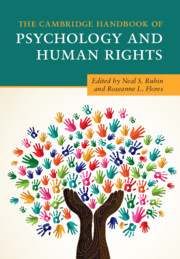Book contents
- The Cambridge Handbook of Psychology and Human Rights
- The Cambridge Handbook of Psychology and Human Rights
- Copyright page
- Dedication
- Contents
- Figures
- Tables
- Boxes
- Contributors
- Acknowledgments
- The Core International Human Rights Instruments and Their Monitoring Bodies
- Universal Human Rights Instruments
- Sustainable Development Goals
- Glossary of United Nations and Psychology Acronyms in the Handbook
- Introduction
- Part I History of Human Rights
- Part II The Intersection of Psychology and Human Rights
- Part III Contemporary Issues in Psychology and Human Rights
- Part IV Teaching, Research, and Training in Psychology and Human Rights
- 31 Decolonization and Liberation Psychology
- 32 Education of Psychologists for Human Rights Awareness, Accountability, and Action
- 33 Conducting Psychological Research across Borders
- 34 Diversity in Psychology Education and Training
- 35 Preparing Future Generations
- Part V Future Directions
- Index
- References
35 - Preparing Future Generations
Critical Considerations and Best Practices in Training Psychologists about the Human Rights of Sexually and Gender-Diverse People and Communities
from Part IV - Teaching, Research, and Training in Psychology and Human Rights
Published online by Cambridge University Press: 02 October 2020
- The Cambridge Handbook of Psychology and Human Rights
- The Cambridge Handbook of Psychology and Human Rights
- Copyright page
- Dedication
- Contents
- Figures
- Tables
- Boxes
- Contributors
- Acknowledgments
- The Core International Human Rights Instruments and Their Monitoring Bodies
- Universal Human Rights Instruments
- Sustainable Development Goals
- Glossary of United Nations and Psychology Acronyms in the Handbook
- Introduction
- Part I History of Human Rights
- Part II The Intersection of Psychology and Human Rights
- Part III Contemporary Issues in Psychology and Human Rights
- Part IV Teaching, Research, and Training in Psychology and Human Rights
- 31 Decolonization and Liberation Psychology
- 32 Education of Psychologists for Human Rights Awareness, Accountability, and Action
- 33 Conducting Psychological Research across Borders
- 34 Diversity in Psychology Education and Training
- 35 Preparing Future Generations
- Part V Future Directions
- Index
- References
Summary
In this chapter, the authors build upon previous chapters that focus on LGBTQI populations and on the education of psychologists about human rights. Here, they focus on the human rights of sexually and gender-diverse people and communities and how best to prepare psychologists for the future direction of psychology as a field that engages in practice, research, advocacy, and outreach. The authors share an international context related to the current status of sexually and gender-diverse people and provide a strong rationale for the need for psychologists to understand the role of human rights in their work with this population. They describe the need for improved training for psychologists about human rights of sexually and gender-diverse people. They provide an overview of current training models and objectives, as well as recommendations for the future.
- Type
- Chapter
- Information
- The Cambridge Handbook of Psychology and Human Rights , pp. 520 - 534Publisher: Cambridge University PressPrint publication year: 2020
References
- 2
- Cited by



